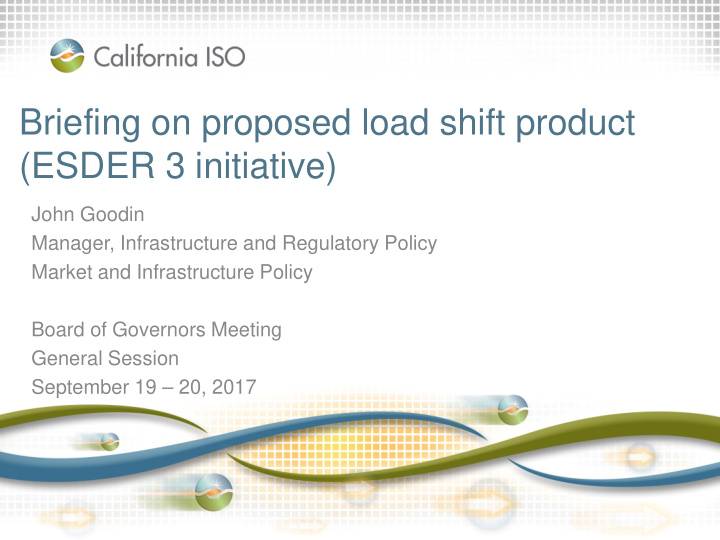



Briefing on proposed load shift product (ESDER 3 initiative) John Goodin Manager, Infrastructure and Regulatory Policy Market and Infrastructure Policy Board of Governors Meeting General Session September 19 – 20, 2017
Why re-branding as load shift vs. load consumption? Policy should incentivize the productive use of clean, green energy and avoid increasing the economy’s energy intensity. – A load consumption product could incentivize wasting energy when a wholesale payment offsets the retail rate payment, i.e. paid to wastefully consume energy. Vs. – A load shift product means excess clean energy can be absorbed and stored and used productively at a different time to the benefit of the economy and environment. Page 2
ISO staff have been meeting with stakeholders from the storage community to consider a potential “load shift” product and its specifications. • Four meetings held to date to: 1. Define the load shift product features; 2. Vet the appropriate ISO participation model; and 3. Identify and address barriers. • Organizations engaged in the effort thus far include: – CESA – Stem – Tesla – Green Charge Page 3
Develop product specifications with a focus on load shift from behind the meter storage to ensure the efficient and productive use of energy. Current effort: Load shift product via non-exporting behind-the-meter storage devices Resource model allowing for “load shift” capability (not Possible future effort : just curtailment as under existing PDR model) Load shift product via traditional load management Apply to sub-metered BTM storage resources Establish clear rules to ensure load shift v. Challenges: incentivizing wasteful and unproductive consumption Maintain separation of LSE and storage provider Establish and apply baselines given consumption Maintain use limitations- not a 24x7 resource would be counter-factual (load consumption not directly metered or verifiable) Maintain RA qualification (not eligible under DERP) Seamless bid curve between charge and discharge Retail rate implications- if new time-of-use rates are intrinsically designed to incentivize shift behavior in Interconnection of non-exporting behind the meter the first instance storage applications Multiple-use applications and value stacking Seamless bid curve between load consumption and curtailment Page 4
Next steps include broader stakeholder engagement and development of proposal within the ESDER3 initiative. 1. ESDER3 will include “load shift” product as a priority item. 2. Stakeholders finalize detailed set of features desired for a behind the meter storage “load shift” product. 3. ISO identifying gaps in tariff provisions and current resource modeling capabilities to enable load shift capability with the desired features. 4. Establish stakeholder working groups and their leads (ISO/CPUC/Industry) within ESDER3 to resolve open issues, as needed and appropriate. 5. Establish a work plan and schedule; target implementation in 2019 Slide 5
Recommend
More recommend